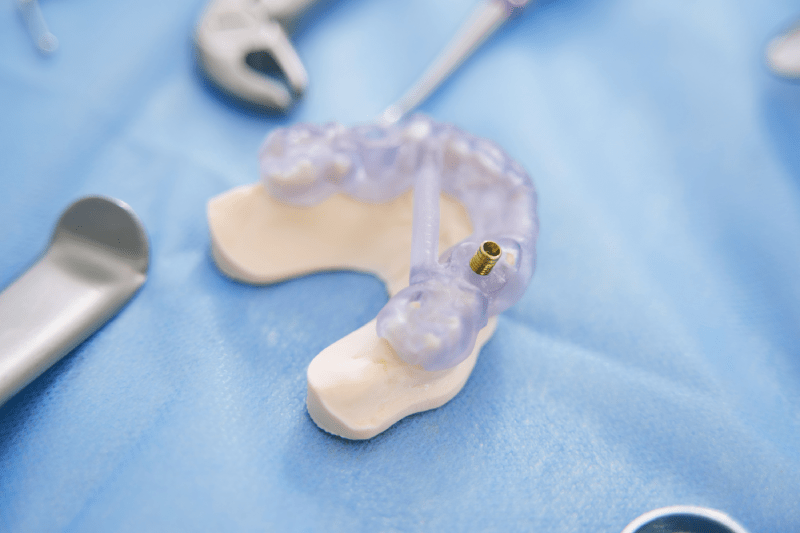What is a Dental Veneer?
Dental veneers are thin layers of porcelain or composite materials applied to the front surface of teeth for aesthetic purposes. These layers improve the color, shape, size, and position of the teeth, resulting in a more aesthetic smile. They are generally used to correct the appearance of chipped, cracked, stained, or gapped teeth. Dental veneers are a popular cosmetic dentistry application because they provide an aesthetic appearance without damaging the natural teeth.
Who Can Get Dental Veneers?
Dental veneers are a suitable treatment method for almost anyone with good oral health who wants to have a more aesthetic smile. Individuals with permanent stains, small cracks, chips, minor crookedness, or gaps between their teeth are ideal candidates. Before the treatment, issues like gum disease and cavities must be resolved. Also, it may not be suitable for those with severe teeth grinding (bruxism) habits, as this can affect the durability of the veneers.
Is the Dental Veneer Procedure Painful?
The dental veneer procedure is generally a painless process. Since only minimal abrasion is done during the procedure, anesthesia is often not even needed. If a tooth is sensitive, local anesthesia can be applied to make the process completely comfortable. After the application, there might be a slight throbbing or sensitivity, but this condition passes quickly and can be controlled with simple painkillers.
How Long Does the Dental Veneer Application Take?
Dental veneer treatment is usually completed in 2-3 sessions. In the first session, impressions of the teeth are taken and preparations are made. These preparations vary depending on the type of veneer; composite veneers can be completed in a single session, while porcelain veneers require a production process in a laboratory. In the second session, the veneers are tried on and final checks are made. In the third session, the veneers are permanently bonded to the teeth.
What Are the Types of Dental Veneers?
There are two main types of dental veneers: Porcelain Veneers (Laminates) and Composite Veneers. Porcelain veneers are thin porcelain sheets that are more durable, stain-resistant, and offer a superior aesthetic appearance. Composite veneers, on the other hand, are a filling material that is directly applied and shaped by the dentist. Composite veneers are more economical but are not as durable as porcelain veneers and their color can change over time.
How Long Do Dental Veneers Last?
The lifespan of dental veneers varies depending on the material used and the patient’s care for their oral hygiene. Porcelain veneers, with good care and regular check-ups, can last for 10-15 years or even longer. The lifespan of composite veneers is generally around 5-7 years. To extend the life of the veneers, it is crucial to avoid biting hard objects and to maintain good oral hygiene.
Do Dental Veneers Damage Teeth?
Dental veneers do not damage teeth when applied correctly. For porcelain veneers, a very minimal amount of abrasion (0.3-0.7 mm) is done on the front surface of the tooth, while in some cases, no abrasion is necessary at all. This minimal procedure preserves the structural integrity of the tooth. For composite veneers, no abrasion is done on the tooth surface.
Can Dental Veneers Fall Off?
The possibility of dental veneers falling off is quite low when they are bonded correctly and cared for properly. However, habits like teeth grinding, nail-biting, or pen-chewing, or a hard impact, can damage the veneers or cause them to come loose. In such cases, your dentist will need to re-bond or replace the veneer.

How Do Dental Veneer Prices Vary?
The cost of dental veneers varies depending on many factors, including the material used (porcelain or composite), the number of veneers, the dentist’s experience, and the location of the clinic. Porcelain veneers are generally more expensive than composite veneers. A detailed examination and a treatment plan prepared by your dentist before the treatment will provide you with a clear price estimate.
What is the Difference Between Porcelain Veneer and Zirconium?
Porcelain veneers (laminates) are thin layers that cover only the front surface of the tooth. Zirconium, on the other hand, is a crown material that covers the entire tooth. Zirconium is often preferred for back teeth where chewing forces are high or for front teeth with significant substance loss. Porcelain veneers offer a more conservative and aesthetic solution.
What Should Oral Care Be Like After Veneers?
Oral care after veneers is no different from the care of natural teeth. You should brush your teeth at least twice a day, and use dental floss or an interdental brush. Even if the surface of the veneers is stain-resistant, it is very important to maintain the health of the tooth and gum areas where the veneer is joined. Regular dental check-ups extend the life of the veneers.
When Should Veneers Be Replaced?
Veneers should be replaced when they are chipped, cracked, excessively discolored, or when a cavity forms underneath the veneer. Also, they may need to be replaced for aesthetic reasons when the gum line recedes and the border between the veneer and the tooth becomes visible. Regular check-ups ensure early detection of these issues.
Are Teeth Abraded for Veneers?
A very small amount (0.3-0.7 mm) of abrasion is performed on the front surface of the tooth for porcelain veneers. This procedure is intended to allow the veneer to fit perfectly on the tooth and to provide a natural look. For composite veneers, no abrasion is generally performed on the tooth surface.
How is the Color of Veneers Chosen?
The color of the veneers is determined by considering the patient’s request, skin tone, facial features, and the color of their other natural teeth. The dentist uses special color scales to choose the most natural and aesthetic shade. Generally, a natural-looking whiteness is preferred over a very white shade.
What is the Difference Between Dental Veneers and Teeth Whitening?
Teeth whitening is a procedure that brightens the natural color of the teeth. Dental veneers, on the other hand, are an aesthetic solution that changes the color, shape, and position of the teeth. Since teeth whitening does not affect veneers, the teeth are whitened before the veneer procedure, and the veneers are then chosen to match the new color.
Do Dental Veneers Prevent Cavity Formation?
Dental veneers prevent cavity formation on the surface where they are applied. However, cavities can form in the marginal areas of the veneer and on other teeth that are not covered. Therefore, a regular and good oral hygiene routine is very important to prevent cavities from forming under and on the sides of the veneered teeth.
How Are Dental Veneers Bonded?
Dental veneers are bonded to the tooth surface with special adhesives (bonding agents) used in dentistry. This bonding process ensures that the veneers adhere firmly to the tooth and last for a long time. The bonded veneers are hardened with a special light to make them permanent.
Do Dental Veneers Look Natural?
Modern porcelain veneers offer a look very similar to natural teeth, thanks to their light-transmitting properties and surface structure. When properly planned and applied by an experienced dentist, it is quite difficult to distinguish the veneers from the natural teeth.
Are Veneers Affected by Stains from Smoking and Coffee?
Porcelain veneers, due to their smooth surface, are very resistant to stains from substances like cigarettes, coffee, and tea. However, composite veneers can get stained and change color over time. Therefore, composite veneers may need to be polished periodically.

Is Sensitivity After Veneers Normal?
It is normal to experience a slight sensitivity to hot and cold after the veneer procedure. This sensitivity usually subsides on its own within a few days. If the sensitivity persists for a long time, it is important to consult your dentist.
Do Dental Veneers Affect Gum Health?
When applied correctly and not putting pressure on the gums, dental veneers do not negatively affect gum health. On the contrary, by eliminating irregularities on the tooth surface, they can help protect gum health. However, if the edges of the veneer do not fit the gum line perfectly, the risk of gum inflammation increases.
Can Teeth Whitening and Veneer Treatment Be Done at the Same Time?
Dental veneers maintain their own color and are not affected by the whitening process. Therefore, the teeth whitening procedure is done first, and then the veneers are designed to match the new color of the teeth. This approach provides the best aesthetic result.
Can Fillings Be Done with Dental Veneers?
Composite veneers are essentially a special filling material and are applied directly to the tooth. In the case of porcelain veneers, if there is a small chip or crack, this area can be repaired with a composite filling. However, for major damage, it may be more appropriate to replace the entire veneer.
How Does Smile Aesthetics Change with Dental Veneers?
Dental veneers can completely transform a person’s smile by changing the color, shape, size, and alignment of the teeth. This results in a more symmetrical, bright, and attractive smile. This aesthetic change also increases the person’s self-confidence.
Does the Habit of Teeth Grinding Affect Veneers?
The habit of teeth grinding (bruxism) can put excessive pressure on the veneers, causing them to chip or crack. Patients with this habit are usually advised to use a night guard. The night guard protects the veneers from the negative effects of grinding.
Are Dental Veneers a Permanent Solution?
Dental veneers are a long-lasting and semi-permanent solution. With proper care, they can be used for years without any problems. However, they may need to be replaced over time due to wear or for aesthetic reasons. Therefore, they should be seen as a long-term aesthetic improvement rather than a permanent solution.
Can Gaps Between Teeth Be Closed with Dental Veneers?
Yes, dental veneers are an effective method for closing gaps between teeth (diastema). The width of the veneers is adjusted to match the natural appearance of the teeth, so these gaps are eliminated aesthetically.
In Which Cases Are Dental Veneers Not Preferred?
Dental veneers are not preferred in cases of severe tooth crookedness, a severe teeth grinding habit, insufficient tooth enamel, teeth with large fillings, or active gum disease. In such situations, orthodontics, zirconium crowns, or other restorative treatments may be more suitable.
What is Done Before Dental Veneer Treatment?
Before dental veneer treatment, the dentist performs a comprehensive oral examination. Tooth decay, gum disease, and existing fillings are checked. These issues are treated if necessary. Photos and impressions of the teeth are taken to create a digital smile design (DSD).
What Should Be Considered After Dental Veneer Treatment?
After veneer treatment, it is important to avoid very hot or cold foods for the first few days. It is also crucial to follow the oral care routine recommended by the dentist, avoid biting hard objects, and not miss regular check-ups.
Can the Color of the Veneer and the Tooth Be Exactly the Same?
Veneers are produced in a color that is as close as possible to the natural teeth. The dentist chooses the shade that best suits the patient’s natural tooth color before bonding the veneers. However, since the material of the veneers is different from natural teeth, there may be minor color differences.

Is the Dental Veneer Procedure Reversible?
Composite veneers are generally reversible as they are applied to the tooth with minimal intervention. However, the procedure is irreversible for porcelain veneers due to the abrasion that is done. Therefore, the decision to get porcelain veneers should be made carefully.
How Successful is Dental Veneer Treatment?
Dental veneer treatment has a very high success rate with proper diagnosis, planning, and application. An experienced dentist and good oral hygiene ensure that the veneers last for a long time. The success is directly related to the patient’s compliance with the treatment and regular check-ups.
How is Smile Aesthetics Designed with Dental Veneers?
Smile aesthetics are designed by considering factors such as the patient’s face shape, lip line, gender, and age. The dentist works on the size, shape, and position of the teeth to create a personalized smile design. In this process, technologies like digital smile design (DSD) can be utilized.
Can Dental Veneers Be Applied to People with a Teeth Clenching Habit?
In patients with a teeth grinding or clenching habit, the risk of veneers breaking is higher. These patients are usually advised to use a night guard. The guard protects the veneers from the forces applied during the night and extends their lifespan.
Choosing the Right Dental Veneer Color
If you have healthy oral hygiene habits, your dental veneers can last for a long time, the average being 10-15 years. Because you are going to use them for a while, it is important that you are perfectly content with how they look.
During your initial consultation with your dentist, you will be shown a chart of possible dental veneer colors according to the type of veneer you are getting. While when picking out the right color for your veneers, there will be several different shades you can choose from according to the natural color of your teeth.
If you are getting a single veneer over one tooth, the right color for your veneers will be an exact match to your natural teeth.
However, if you wish for a smile makeover and get full jaw (upper or lower teeth) or full mouth (both upper and lower teeth) dental veneers, you can aim for a whiter smile. In this case, your veneers will usually be a couple of shades brighter than your natural teeth.
What Are BL Tooth Shades?
While most of the color shades available for dental veneers mimic natural tooth shades, there is an option to have even whiter veneers. These bleached white shade veneers are whiter than the brightest shade of natural teeth. In the veneer color chart, these shades can be indicated as Bleach 1 (BL1) up to Bleach 4 (BL4), BL1 being the whitest, and BL4 closest to natural shades.
This categorization can change depending on the dental clinic or veneer type. However, know that there are shades whiter than natural colors available.
How to Decide on the Best Dental Veneer Color
Deciding on the color of dental veneers can be an emotional experience for the patients as the smile is such an important part of their appearance. Patients usually want a whiter smile that isn’t too white that it looks unnatural. Your dentist will support you to find the best color using their experience. When deciding which shade of color best suits you, there are a couple of factors to consider;
Natural Teeth: The biggest factor when choosing the right shade for your veneers is the color of your own natural teeth. If you are getting a single veneer, the veneer should not be darker than a couple of shades as more than that could draw attention to the veneer. However, if you are getting a smile makeover, you can go as bright as you want while paying attention to other factors.
White Part of Your Eyes: It is common practice that dental veneers are matched to the color of the white part of the eyes. When the color of the teeth complements the white part of the eyes, it creates harmony in your appearance and looks natural.
Skin Tone: Another important factor when choosing dental veneer shade is skin color. Experts advise those with fairer skin tones to choose brighter, whiter shades, such as the bleached shades of BL1-BL4. It is recommended that those with darker skin tones consider a more natural veneer shade and avoid bleach shades, as bright white and bleach shades can look unnatural on darker skin tones.
Personality: Your personality is yet another crucial factor. If you want a glamorous and noticeably white smile like famous movie stars, you can go for brighter colors. Or if you want to have a more subtle yet attractive smile makeover, you can choose from the more natural-looking color shades.
Most dentists would say that two shades lighter than your natural teeth will produce realistic results. You should discuss your preferences with your dentist. Every patient has unique goals for getting dental veneers and the purpose of veneers is to assist in achieving these goals while complimenting your natural charm.
Dental Veneers in Turkey
Dental veneers are a great alternative for addressing cosmetic problems concerning teeth. They can, however, also be quite costly in some places. For example, while a single veneer per tooth can cost more than 600€ in the United Kingdom, a full smile makeover can cost more the €12,000.
Because of the high costs and long wait times, many people from all over the world are increasingly traveling abroad for dental treatments such as dental veneers. Among the travel destinations, Turkey is a popular option that is known for being very affordable. while providing high-quality dental veneer treatments with excellent customer service. The cost of living in Turkey is low, and currency exchange rates are favorable. As a result, international patients can receive dental treatments at reasonable prices.
In Turkish dental clinics, a single dental veneer per tooth can cost €130-150, whereas a full Hollywood smile makeover can cost around €3300, saving a significant amount of money.
You can be sure that Turkish dental clinics don’t sacrifice treatment quality in exchange for lower prices. The dental implants you receive would be the same as those available in Europe or the United States. However, the treatment costs would be much lower, and skilled and experienced dentists will provide you with excellent attention and care.



